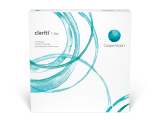
clariti® 1 day offers the benefits of convenience, comfort, and ocular health, all in an extremely affordable daily silicone hydrogel lens.*
Daily disposable contact lenses continue to lead the market share of soft lens fits.1 In fact, a recent international survey of eye care professionals (ECPs) found that soft daily disposables account for almost half of this category, followed by monthly and then weekly/biweekly lens fits at 34% and 15%, respectively.1
Considering materials, a separate international survey reported 90% of ECPs agreed that SiHy is the healthiest lens material for daily disposable patients.2 However, a vast majority of ECPs in the same study cited the high cost of SiHy daily disposals as the main reason why they didn’t prescribe these lenses to more of their patients.2
clairiti® 1 day, a highly affordable, 1-day SiHy lens, is uniquely positioned to fill this gap.* clariti® 1 day offers frequent replacement wearers the opportunity to upgrade into a daily lens which offers a convenient, comfortable wearing experience 2,3 combined with the ocular health benefits of a silicone hydrogel.†
Dr. Jennifer Stewart, OD, of Look New Canaan shares how ECPs can grow their practice by upgrading their reusable lens wearers into clariti® 1 day.
How can a migration from reusable lenses to dailies, and specifically clariti® 1 day, be a practice builder for ECPs?
Patients who wear daily disposable contact lenses are a huge opportunity for practices. These patients tend to return more frequently for their exams and have far better compliance than reusable lens wearers.4,5 They don’t “stretch” the wear time of these lenses, and when purchasing an annual supply, these patients tend to return like clockwork for their exam in one year.4,5 In general, daily contact lens wearers also tend to be more satisfied in lens wear overall since they have less contact lens-related dryness and discomfort, and therefore less dropout.6 I find these patients to be a huge practice builder with referrals. I’m also still continuously amazed how excited patients are when given the option of daily disposable lenses. Even though they have been around a long time, many patients haven’t had them presented as an option.
I call clariti® 1 day my “workhorse” lens. It’s the perfect lens choice when migrating patients from a reusable lens and has fantastic comfort, handling and optics.‡
It’s also priced very well and can make the transition to the daily disposable modality less of an issue.
Cost is sometimes perceived as a prohibitive factor for patients when considering a shift from a reusable lens to a 1-day. What is that conversation like for you in the exam room when discussing clariti® 1 day with your frequent replacement lens wearers?
I always like to address cost, which is the elephant in the room! I start by watching body language when I begin talking about daily disposable lenses. If a patient leans back, crosses their arms, or looks doubtful, I usually guess that cost is the main reason for their responses. I address this head-on and say, “Many of my patients have heard that daily disposable lenses are more expensive. Is that something you’ve also heard?”
I then talk about the hidden costs of reusable lenses, or what I call the “grocery bill.” I explain that when comparing the lens cost ONLY, daily disposable lenses are more expensive than reusable lenses, because there are more of them. I then bring up the additional cost of cases and solutions necessary for proper cleaning and care of reusable lenses. I’ll lighten the mood by adding, “Wow, those costs have really gone up lately!” This comparison helps the patient see that the cost of the daily disposable annual supply is comparable to that of reusable lenses when cases and solutions are included.
Also, I don’t ask the patient if they want to try clariti® 1 day. Instead, I say, “The good news is there is an amazing daily disposable lens that is well-priced and available in your prescription. I’m going to send you home with the lenses and have my office check in with you in a week. Remember, throw them out tonight, and you get to put on a fresh pair tomorrow morning.”
The lens that I typically choose is clariti® 1 day, because it is a great lens at a price point that helps this conversation.7
What are the benefits of a 1-day lens, and what key benefits do you share with patients thinking about upgrading to clariti® 1 day?
I love to remind patients that contact lenses are one of the only things we reuse, and I ask them how their lenses feel after a week, two weeks, and a month. Do the lenses feel as comfortable as day one? I share the benefits, that every single day, they will start with a fresh, clean lens. Not only will they have consistent comfort, but they will also see better as the lens doesn’t get coated with tears, oils, makeup, and other facial products.6, I also let them know that a daily disposable lens is the healthiest option.§6,8.9
How does clariti® 1 day compare when considering optics, handling, material, and comfort vs. frequent replacement lenses?
Because the lens is being thrown out daily, clariti® 1 day has a clean surface every day. I tell patients, it’s like how you see when you clean your glasses. WOW! We don’t realize how dirty they are until they’re cleaned. Contact lenses can develop deposits on their surface throughout the day.6,8,9 This can lead to contact lens drop out, all which can be helped with clariti® 1 day. 6,8.9
Is sustainability a speaking point in the exam room when discussing a move from a reusable lens to clariti® 1 day?
I find the sustainability piece to be another huge opportunity in patient education. There is a hesitation sometimes from patients when discussing daily disposables, which often comes down to the amount of packaging used in a new pair of lenses each day versus that in a biweekly or monthly lens. I love changing the narrative and talking about net plastic neutrality. This acknowledges and validates their concerns but also gives them information to know they are making an informed decision that is also good for the environment. I love sharing statistics about how much plastic is stopped from entering the ocean from annual contact lens supplies.10-12 It is such a great conversation starter and way to set yourself apart.
(Lenses in the clariti® 1 day family are the first net plastic neutral contact lenses in the U.S. ** | ¶). 13,14
Are there any other points that you’d like to share when considering migrating patients from reusable lenses to clariti® 1 day?
Make it a point to fit your next five reusable lens patients in clariti® 1 day. Too often we get stuck in old habits and routines and changing a behavior takes time and effort.
Dr. Jennifer Stewart is an optometrist, speaker, writer, consultant, and entrepreneur. She has been involved in the optometric community for almost 20 years as a private practice owner.
* Based on 166 participating eye care professionals in a multi-national online survey, 2016.
† With higher oxygen delivery than hydrogel materials, SiHy materials minimize or eliminate hypoxia-related complications during daily wear.
‡ Prospective, single day, randomized, double-masked, non-dispensing, contralateral eye study of habitual reusable wearers, Vision and comfort are comparable and similar to 1 DAY ACUVUE® MOIST, insertion is superior. n=60.
§ When used and worn compliantly.
**Based on top 4 global contact lens manufacturers.
| clariti® 1 day is defined as orders and includes clariti® 1 day sphere, clariti® 1 day toric, and clariti® 1 day multifocal product sold and distributed by CooperVision in the US.
¶ Net plastic neutrality is established by purchasing credits from Plastic Bank. A credit represents the collection and conversion of one kilogram of plastic that may reach or be destined for waterways. CooperVision purchases credits equal to the weight of plastic in clariti® 1 day orders in a specified time period. clariti® 1 day plastic is determined by the weight of plastic in the blister, the lens, and the secondary package, including laminates, adhesives, and auxiliary inputs (e.g. ink).
1. Morgan PB, et al. International contact lens prescribing in 2022. Contact Lens Spectrum. https://www.clspectrum.com/issues/2023/january-2023/international-contact-lens-prescribing-in-2022.
2. Orsborn G., Dumbleton K.: Eye care professionals’ perceptions of the benefits of daily disposable silicone hydrogel contact lenses. Cont Lens Anterior Eye 2019; 42: pp. 373-379.
3. CVI data on file, 2018. Survey results of ECPs in US, UK and Japan, n=300.4. Dumbleton K, Richter D, Bergenske P, Jones LW. Compliance with lens replacement and the interval between eye examinations. Optom Vis Sci. 2013 Apr;90:351-358.
5. Dumbleton K, Richter D, Woods C, Jones L, Fonn D. Compliance with contact lens replacement in Canada and the United States. Optom Vis Sci. 2010 Feb;87:131-139.
6. Sulley A, Dumbleton K. Silicone hydrogel daily disposable benefits: The evidence. Contact Lens Anterior Eye. 2020 Jun;43(3):298-307.
7. CVI data on file 2022. Verve Online Survey with US ECPs who fit clariti® 1 day or private label version. n=121 (79% strongly agree/agree).8. Chalmers RL, Hickson-Curran SB, Keay L, Gleason WJ, Albright R. Rates of adverse events with hydrogel and silicone hydrogel daily disposable lenses in a large postmarket surveillance registry: the TEMPO Registry. Invest Ophthalmol Vis Sci. 2015 Jan 8;56:654-663.
9. Stapleton F, Keay L, Edwards K, et al. The incidence of contact lens-related microbial keratitis in Australia. Ophthalmology. 2008 Oct;115:1655-1662.
10. National Academies of Sciences, Engineering, and Medicine, through the National Oceanic and Atmospheric Administration (NOAA), 2020, https://www.nationalacademies.org/our-work/united-states-contributions-to-global-ocean-plastic-waste
11.Plastic Bottles: The plastic bottle equivalent of KG extracted, 1KG is the equivalent of 50 single use plastic bottles.
12. Net plastic neutrality is established by purchasing credits from Plastic Bank. A credit represents the collection and conversion of one kilogram of plastic that may reach or be destined for waterway. CooperVision purchases credits equal to the weight of plastic in participating product orders in a specified time period. Participating product plastic is determined by the weight of plastic in the blister, the lens, and the secondary package, including laminates, adhesives, and auxiliary inputs (e.g. ink).
13.CVI data on file 2019. Randomized, double-masked, 1-week DD dispensing study with clariti® 1 day, single site UK, n=53.
14. CVI data on file, 2022.








